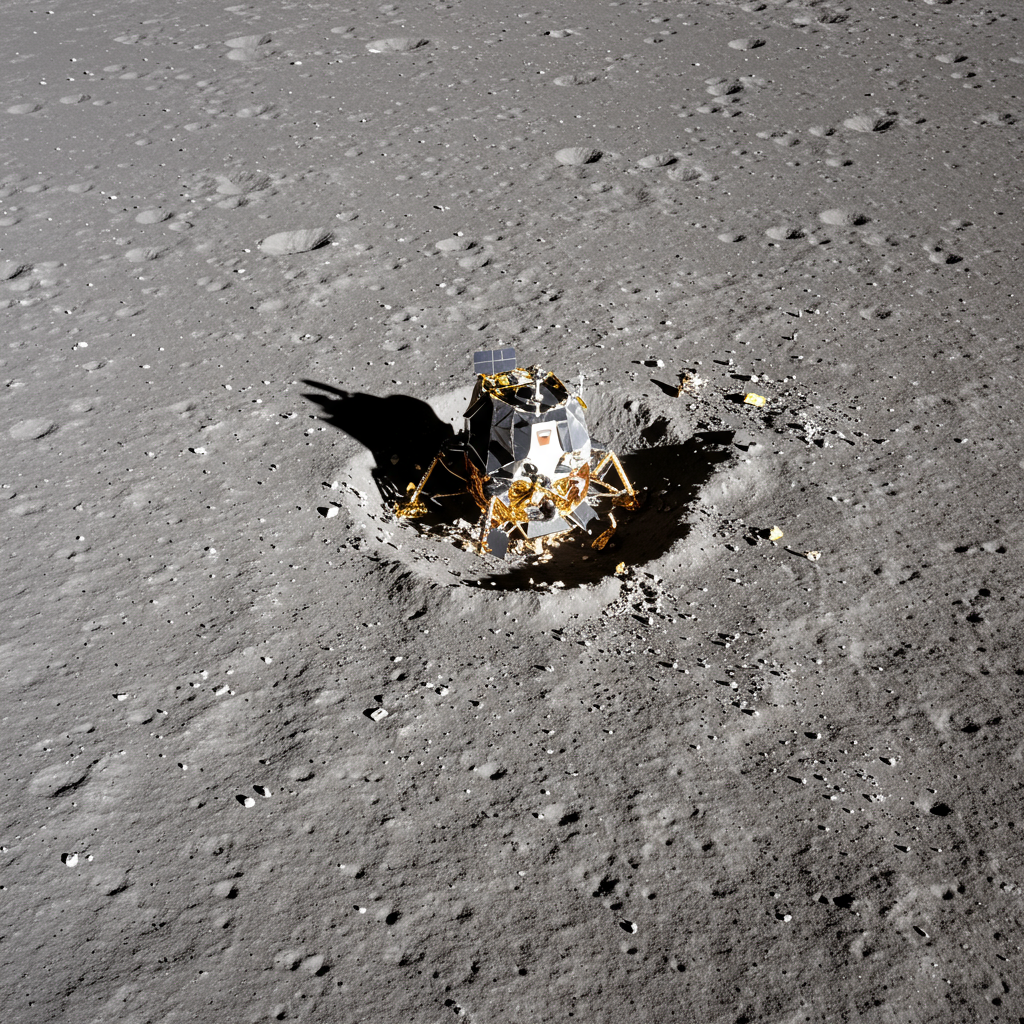Japanese Moon Lander Crashes: Laser Rangefinder Malfunction Blamed
Japanese company ispace’s private lunar lander, named Resilience, tragically crashed onto the moon’s surface during a landing attempt on June 5, 2025. This marks the second consecutive mission failure for ispace, following the loss of their Hakuto-R lander in 2023. The company has now confirmed the cause: a critical malfunction in the spacecraft’s laser range finder.
The incident occurred as Resilience attempted a touchdown near the Mare Frigoris region, also known as the “Sea of Cold,” on the moon’s near side. Communication with the lander was lost just moments before its scheduled landing time.
Why the Lander Crashed
According to ispace’s investigation, the core issue lay with the spacecraft’s laser range finder (LRF). This vital instrument is designed to precisely measure the lander’s distance from the lunar surface during the complex descent phase. However, the LRF experienced an anomaly, either failing to obtain valid measurements or transmitting data with a significant delay.
This incorrect or delayed altitude data prevented Resilience’s systems from initiating the necessary deceleration maneuvers at the proper time and rate. At the point communication was lost, the lander was still at an altitude of approximately 192 meters (630 feet) but descending rapidly at a speed of 42 meters per second (roughly 138 feet per second). With insufficient distance remaining to brake, the spacecraft impacted the surface just five seconds later, resulting in a “hard landing” or crash.
While the exact root cause of the LRF anomaly is still under investigation, ispace identified several likely contributing factors. These possibilities include:
Unexpected reflectivity properties of the lunar surface at the landing site.
The angle at which the laser hit the surface, potentially reducing the amount of light reflected back.
Lower-than-expected laser power output from the lander’s system.
Potential degradation of the device’s performance during its lengthy flight to the moon or insufficient performance capabilities from the outset.
Experts at ispace currently lean towards the explanation of device degradation or initially insufficient performance as the more probable cause compared to installation errors.
A Second Setback for ispace
This failure is particularly poignant as it follows the unsuccessful landing attempt of ispace’s first lander, Hakuto-R, in April 2023. Interestingly, while both missions ended in a crash, the technical issues differed. The Hakuto-R failure was attributed to a software error where the system misinterpreted a large cliff face as an erroneous reading, causing the lander to run out of fuel far above the surface.
For the Resilience mission, ispace had reportedly improved the software, refined the approach strategy, and even used a new type of laser range finder from a different supplier. Despite these efforts, a different technical issue led to a similar devastating outcome during the final minutes of descent.
Approximately two weeks after the incident, NASA’s Lunar Reconnaissance Orbiter (LRO), orbiting the moon, successfully imaged the crash site. The LRO captured a distinct dark smudge on the lunar surface, surrounded by a subtle bright halo. This feature is consistent with the impact of the lander disturbing the lunar regolith, or moon dust, visually confirming the location and nature of the landing failure.
What Was Lost
Beyond the lander itself, the crash resulted in the destruction of valuable payloads onboard. These included:
A small Tenacious rover, developed by ispace’s European subsidiary with funding from the Luxembourg Space Agency and ESA. Made of carbon fiber, this rover carried a high-definition camera and a shovel for collecting lunar soil, part of a contract to sell a sample to NASA as a proof of concept for commercial resource acquisition.
A water electrolyzer experiment aimed at demonstrating the splitting of water into hydrogen and oxygen, a key technology for potential future lunar bases.
Various other instruments and experiments, such as additional cameras, a food production experiment, a radiation monitor, and a unique Swedish art project in the form of a small red cottage.
Looking Ahead: ispace’s Future Plans
Despite two consecutive landing failures, ispace remains resolute in its commitment to lunar exploration. CEO Takeshi Hakamada acknowledged the seriousness of the second crash and apologized to stakeholders, emphasizing the company’s determination to continue.
Ispace is already taking steps for its future missions. The company plans to significantly strengthen the testing and verification processes for its landing sensors, including laser range finders, and improve the overall landing system hardware based on lessons learned. They have already decided to incorporate additional vision-based landing sensors alongside LRFs on their next two scheduled missions.
The third mission (Mission 3) is currently planned for 2027, and ispace is also preparing for a fourth (Mission 4). These missions will utilize a larger, more capable lander design known as Apex 1.0. Notably, the Mission 3 effort involves a partnership between ispace’s U.S. subsidiary and Draper Laboratory and will operate under NASA’s Commercial Lunar Payload Services (CLPS) program, similar to successful American competitors. The planned landing site for Mission 3 is the 320-kilometer Schrödinger crater near the Moon’s South Pole.
While ispace’s CEO stated they “have not stepped down in the face of setbacks” and are focused on rebuilding trust, the company anticipates that the necessary additional testing and improvements will increase development costs, potentially by over $10 million. ispace also plans to invite external experts to review the incident and work more closely with the Japan Aerospace Exploration Agency (JAXA) on technical matters.
The Tough Reality of Private Moon Missions
The challenges faced by ispace highlight the inherent difficulty of achieving a successful soft landing on the moon. The recent surge in private companies attempting lunar exploration has seen significantly more failures than successes since 2019. Out of seven recent private landing attempts, only one – Firefly Aerospace’s Blue Ghost lander – has been fully successful, operating for its planned two weeks after launching on the same* SpaceX rocket as Resilience in January. Other recent attempts, like Intuitive Machines’ lander, reached the surface but tipped over, while Astrobotic’s first lander failed shortly after leaving Earth orbit.
Historically, achieving a soft lunar landing has been an exclusive feat, accomplished by only five countries: the Soviet Union, the United States, China, India, and Japan (Japan’s SLIM lander achieved a tricky ‘pinpoint’ landing in 2024, though it initially landed at an angle). The United States remains the only nation to have landed humans on the moon. The entry of commercial entities like ispace adds a new, challenging dimension to the ongoing race to the moon. Despite the setbacks, companies like ispace remain committed, viewing each mission, successful or not, as a crucial steppingstone toward establishing a sustainable commercial presence on the lunar surface.




